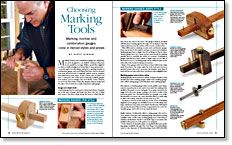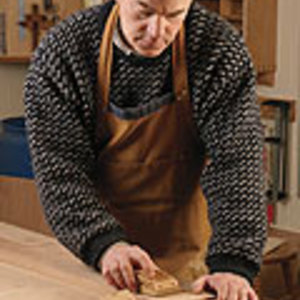Choosing Marking Tools
Marking, mortise and combination gauges come in myriad styles and prices
Synopsis: Marking gauges employ knives and wheels, and each design has its advantages. Mortise gauges employ two cutters for parallel lines. This objective overview shows the various styles and products and gives recommendations on purchasing and maintaining these shop essentials.
Marking, mortise and combination gauges are simple layout tools designed to cut shallow reference lines into the wood, parallel to an edge. While a pencil line might be too thick or easily smudged, an incised line is clean and precise.
Look through a woodworking catalog for a marking, mortise, or combination gauge, and you’ll likely find that choices abound, from basic all-wood tools to elegantly crafted versions complete with inlaid brass wear strips. To get a better idea of what’s out there, I surveyed a few of the most commonly available gauges, from makers such as Bridge City Tool Works, Colen Clenton, Crown Tools, Glen-Drake Toolworks, Marples, Starrett, Veritas, and Woodjoy. I also looked at a couple of Japanese-style gauges.
A typical gauge has two main parts: a beam and a fence. Depending on the type of gauge, the beam may have one, two, or three steel cutters. The fence slides along the beam to adjust the distance from the cutter to the fence. The gauge is held in one hand with the fence bearing against the edge of a workpiece; then the cutter is drawn across the surface of the wood to scribe a line.
What differentiates marking, mortise and combination gauges from one another is the number and type of cutters each employs. Marking gauges have a single cutter for scribing one line at a time. Mortise gauges have two cutters and are used mostly for marking parallel lines to establish the width of a mortise. Combination gauges typically have three cutters: a single cutter on one side of the beam for use as a marking gauge and an additional pair on the other side of the beam for laying out mortises.
Many of the gauges with wood fences have inlaid wear strips made from brass. The strips make the tools look nicer, but as a practical matter, they aren’t necessary. My Marples, more than 25 years old, has no brass in the fence and shows only negligible wear.
From Fine Woodworking #164
For the full article, download the PDF below.
Fine Woodworking Recommended Products

Stanley Powerlock 16-ft. tape measure

Lie-Nielsen No. 102 Low Angle Block Plane

Starrett 12-in. combination square





















Log in or create an account to post a comment.
Sign up Log in